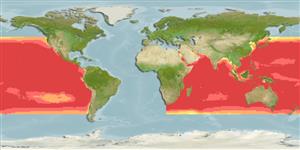Classificação / Names
Common names from other countries
Referência principal
Tamanho / Peso / Idade
Max length : 420 cm TL macho/indeterminado; (Ref. 30874); common length : 290 cm TL macho/indeterminado; (Ref. 9308); Peso máx. publicado: 440.0 kg (Ref. 30874)
Length at first maturity
Lm 210.0, range 190 - ? cm
Ambiente
; marinhas; oceanódromo (Ref. 51243); intervalo de profundidade 0 - 200 m (Ref. 43)
Clima / Intervalo
Subtropical; 20°C - 25°C (Ref. 54918), preferred 28°C (Ref. 107945); 46°N - 47°S, 19°E - 69°W (Ref. 54918)
Distribuição
Indo-Pacific: tropical, subtropical and temperate waters. Highly migratory species, Annex I of the 1982 Convention on the Law of the Sea (Ref. 26139).
The distribution in the Pacific Ocean is unique among billfishes and tunas in that it forms a horseshoe-shaped pattern from the northwest Pacific through the eastern Pacific to the southwest Pacific (Ref. 30443). In the Indian Ocean, fish are more densely distributed in equatorial regions with higher concentrations off eastern Africa, in the western Arabian Sea, the Bay of Bengal and off northwestern Australia (Ref. 30444).
Países | Áreas FAO | Ecossistemas | Ocorrências | Introduções
Descrição breve
Espinhos dorsais (total): 0; Raios dorsais moles (total): 42-48; Espinhos anais 0; Raios anais moles: 18 - 24. Body elongated and compressed; upper jaw produced into a robust and medium sized beak; two dorsal fins, the height of the first greater than the greatest depth, short anteriorly, taller in the middle, then becoming shorter posteriorly; pectoral fins falcate and flexible, with 18 to 22 rays; body densely covered by small, embedded scales with 1 or 2 bluntish points; back dark blue; belly silvery; membrane of first dorsal fin blue black without dark spots; flanks with about 20 bluish stripes (Ref. 55763). Blue-black above and silvery white below, with about 15 rows of cobalt-colored stripes; 1st dorsal fin dark blue; other fins dark brown, sometimes with a tinge of dark blue; anal fin bases with a tinge of silvery white.
Categoria na Lista Vermelha da IUCN (Ref. 115185)
Ameaça para o homem
Harmless
Utilização humana
Pescarias: espécies comerciais; peixe desportivo: sim
Mais informação
ReferênciasAquaculturaPerfil para aquaculturaEstirpesGenéticaFrequência dos alelosHereditariedadeDoençasProcessamentoMass conversion
Ferramentas
Relatórios especiais
Descarregue XML
Fontes da internet
Estimates of some properties based on models
Phylogenetic diversity index
PD50 = 0.7505 many relatives (e.g. carps) 0.5 - 2.0 few relatives (e.g. lungfishes)
Nível Trófico
4.5 ±0.77 se; Based on food items.
Resiliência
Baixo, tempo mínimo de duplicação da população 4,5 - 14 anos (rm=0.09; K=0.2-0.6; tm=2-3; Fec=90-281 million (annual reproductive output))
Vulnerabilidade
Moderate vulnerability (43 of 100)
Categoria de preço
